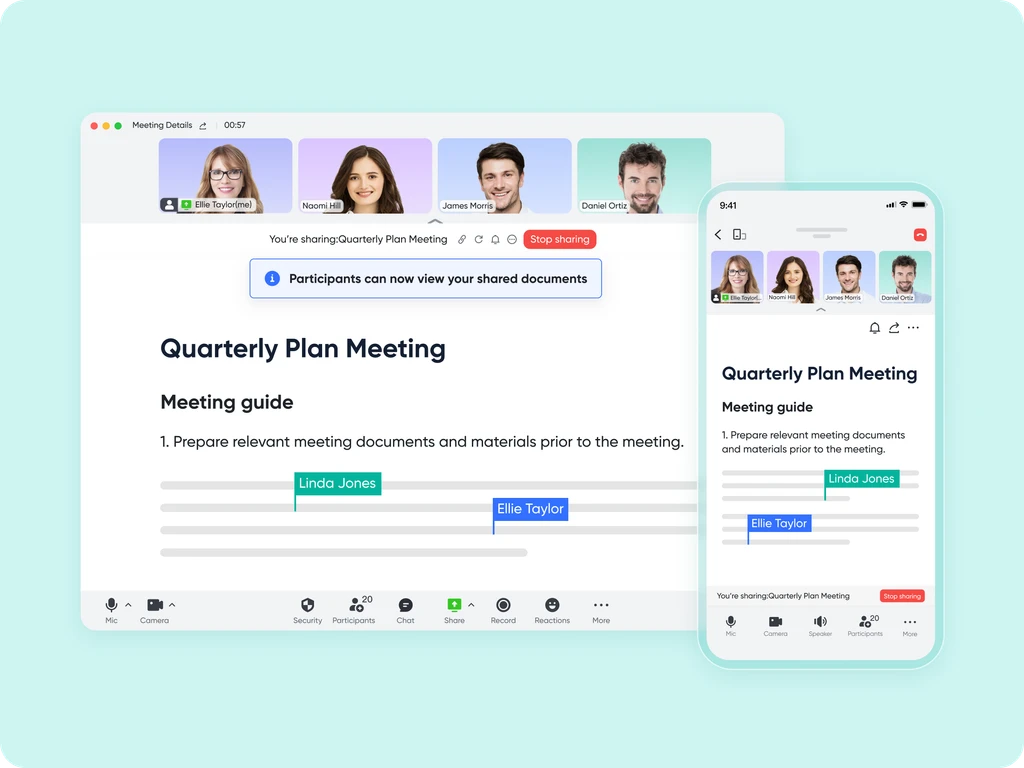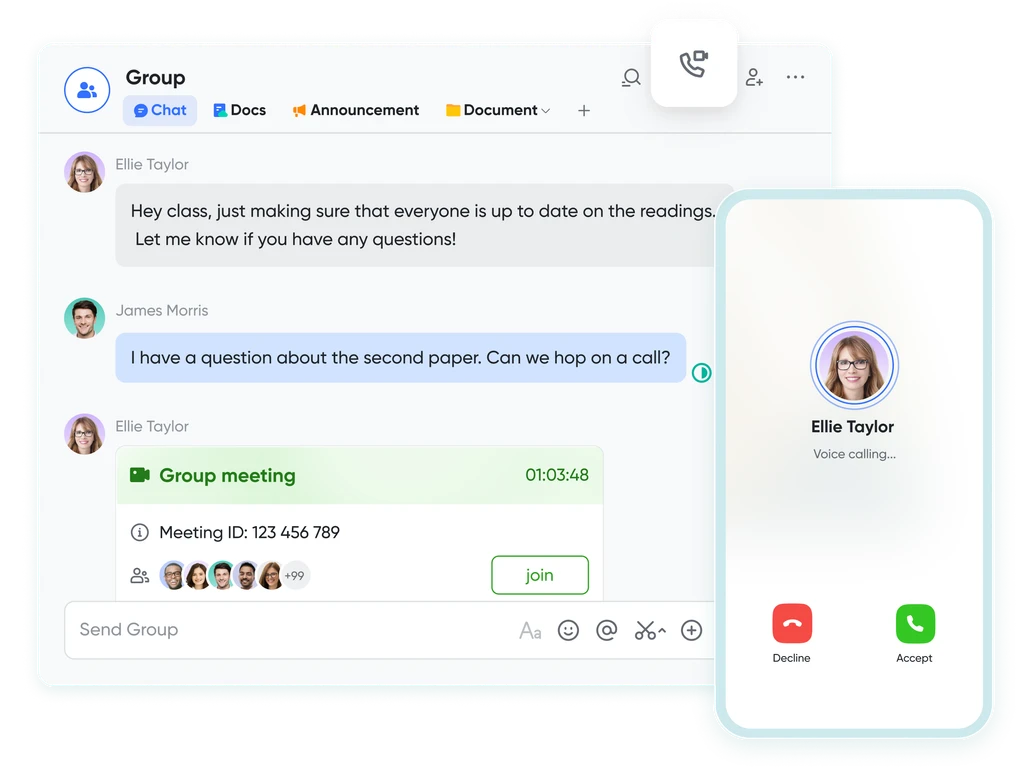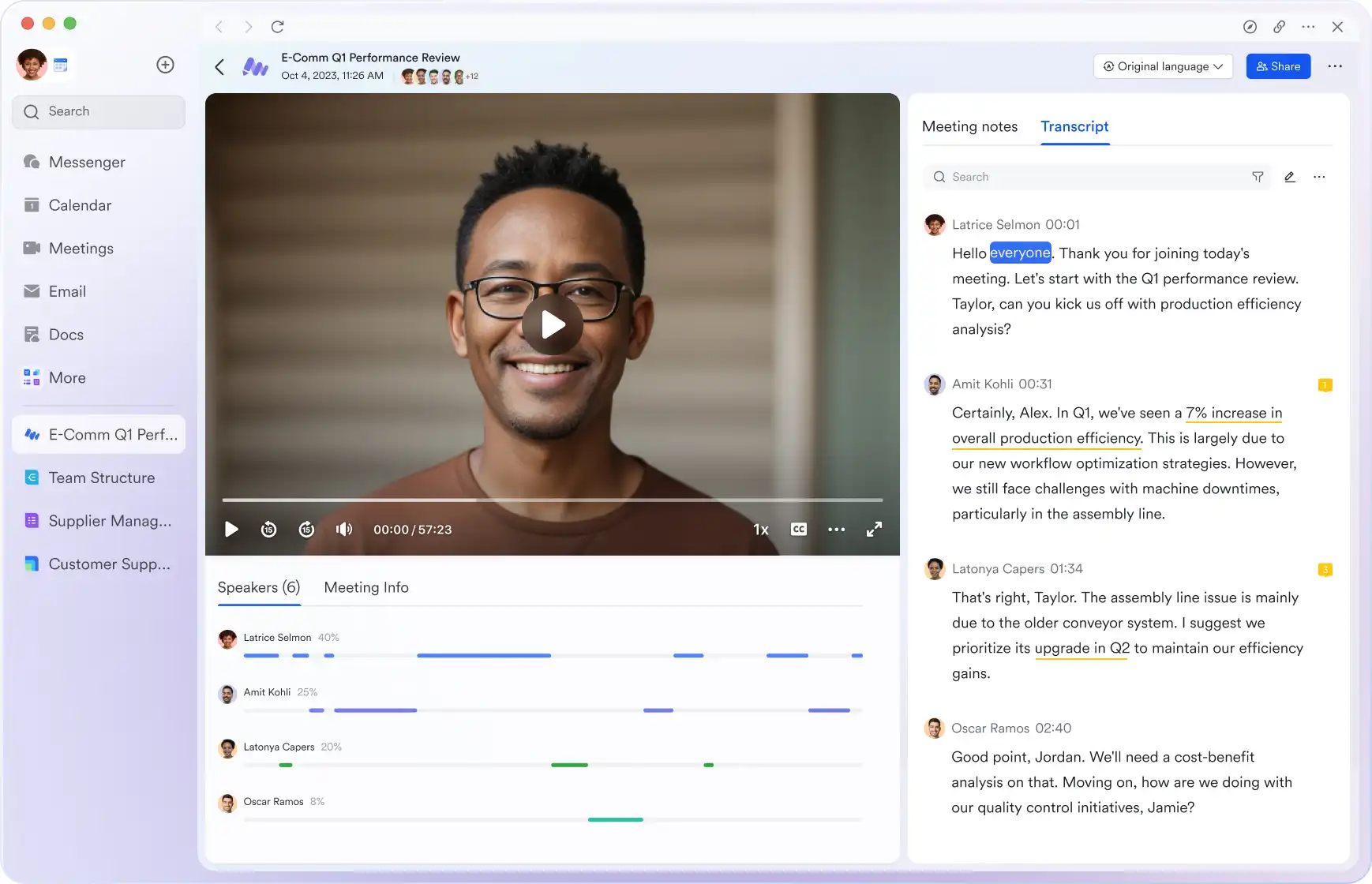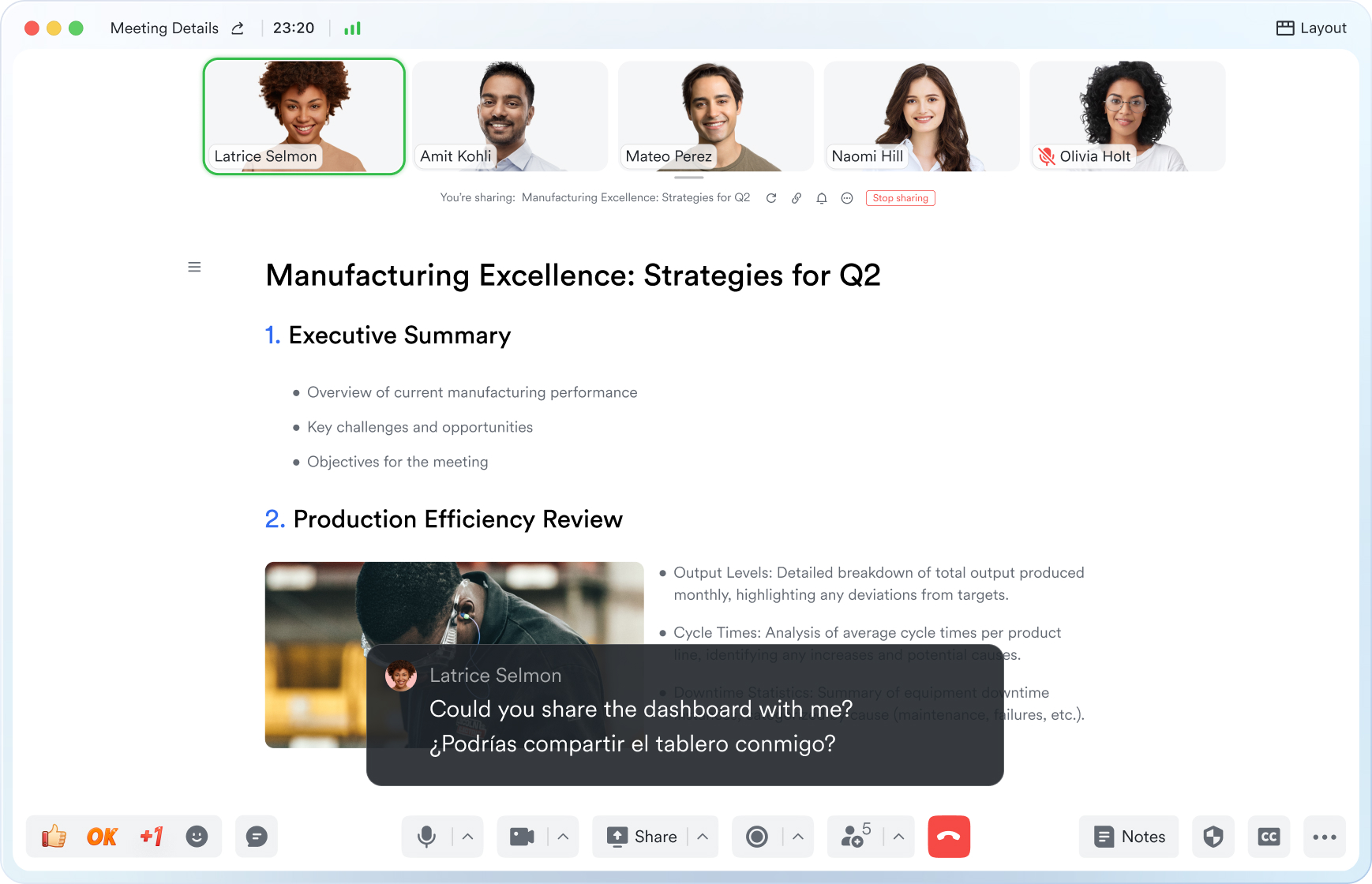Quality Circle Meeting
This guide will walk you through the essential elements of use quality circle meeting to keep your attendees aligned and engaged.
Try Lark for Free
Quality circle meetings are a fundamental component of quality management, focusing on enhancing product or service quality, process efficiency, and employee engagement. These meetings empower cross-functional teams to identify and address quality-related issues while fostering a culture of continuous improvement. In this comprehensive guide, we'll explore the significance of quality circle meetings, how to conduct them effectively, and best practices for driving continuous improvement.
Use Lark Meetings to turn meetings into true collaborative experiences.
What is a quality circle meeting?
Empowering Employee Involvement
A quality circle meeting is a structured and regular gathering of a small group of employees who collaborate to identify, analyze, and solve quality-related problems within an organization. These meetings promote active employee involvement in quality improvement initiatives.
Goals of quality circle meetings
Continuous Improvement and Engagement
The primary goals of quality circle meetings include:
- Problem Identification: Identifying quality-related problems, challenges, or opportunities for improvement.
- Problem Analysis: Analyzing the root causes of identified issues to gain a deeper understanding.
- Solution Generation: Collaboratively generating potential solutions or process improvements.
- Implementation Planning: Planning the implementation of selected solutions or improvements.
- Monitoring and Evaluation: Continuously monitoring the effectiveness of implemented solutions.
- Employee Engagement: Encouraging employee involvement, empowerment, and teamwork.
Who should attend quality circle meetings?
Employee Involvement
Quality circle meetings typically involve employees who are directly engaged in the processes or tasks related to the identified quality issues. Key participants may include:
- Quality Circle Members: Employees actively participating in the quality circle.
- Facilitator: A designated individual responsible for guiding the meeting and ensuring its effectiveness.
- Supervisors or Managers: Individuals who provide support, resources, and approvals for quality improvements.
Learn more about Lark x Meetings
Topics and agenda for quality circle meetings
Focused Discussions
An effective quality circle meeting follows a structured agenda that covers essential aspects of quality improvement. Here are key topics to include:
- Welcome and Introduction: Begin with introductions and an overview of the meeting's purpose.
- Problem Presentation: Present the identified quality-related problem or challenge for discussion.
- Problem Analysis: Analyze the problem's root causes, using tools like root cause analysis (RCA).
- Solution Brainstorming: Collaboratively brainstorm potential solutions or process improvements.
- Solution Selection: Evaluate and prioritize potential solutions based on feasibility and impact.
- Implementation Planning: Develop a plan for implementing the selected solution or improvement.
- Responsibility Assignment: Define roles and responsibilities for implementing the solution.
- Monitoring and Evaluation: Establish metrics and methods for monitoring the solution's effectiveness.
- Progress Update: Provide updates on the status and progress of previously implemented solutions.
- Employee Feedback: Encourage team members to share feedback, suggestions, and concerns.
- Recognition and Appreciation: Acknowledge team members' contributions and commitment.
- Closure and Recap: Conclude the meeting with a recap of key takeaways, action items, and next steps.
How to conduct an effective quality circle meeting?
Empowering Teamwork and Improvement
Conducting an effective quality circle meeting requires active facilitation, teamwork, and a focus on solutions. Here's a step-by-step guide to ensure a productive discussion:
- Preparation: Define the meeting's objectives, create an agenda, and invite relevant participants.
- Problem Presentation: Clearly present the identified quality-related problem or challenge, providing context and background.
- Agenda Distribution: Share the meeting agenda in advance to allow participants to prepare and contribute effectively.
- Meeting Facilitation: Appoint a skilled facilitator to guide the meeting, maintain focus, and manage time.
- Problem Analysis: Use tools like root cause analysis (RCA) to analyze the problem's root causes thoroughly.
- Solution Brainstorming: Encourage open and creative brainstorming sessions to generate potential solutions.
- Solution Selection: Evaluate and prioritize potential solutions based on feasibility, impact, and resources.
- Implementation Planning: Develop a detailed plan for implementing the selected solution or improvement, including timelines and responsibilities.
- Responsibility Assignment: Clearly define roles and responsibilities for each team member involved in the implementation.
- Monitoring and Evaluation: Establish clear metrics and methods for monitoring the effectiveness of the solution over time.
- Progress Update: Provide updates on previously implemented solutions, including any lessons learned or adjustments made.
- Employee Feedback: Create a safe and open environment for team members to share feedback, suggestions, and concerns related to quality improvement.
- Recognition and Appreciation: Acknowledge and celebrate team members' contributions and dedication to quality improvement.
- Closure and Recap: Conclude the meeting with a recap of key takeaways, action items, and a sense of empowerment and teamwork.
Learn more about Lark x Meetings
Examples of quality circle meetings
Real-world scenarios
Real-world scenarios
Let's explore three real-world scenarios of effective quality circle meetings in different contexts:
Scenario 1: Manufacturing Quality Circle Meeting
Brief Content: A quality circle within a manufacturing plant conducts a meeting to address a recurring issue of product defects on the production line.
Detailed Content: The quality circle meeting begins with an overview of the issue: an increasing number of product defects affecting quality and customer satisfaction. The team conducts a thorough root cause analysis (RCA) to identify the underlying reasons behind the defects, discovering issues with a specific machine's calibration. The team then brainstorms potential solutions, which include recalibrating the machine and implementing stricter quality checks at critical points in the production process. They prioritize these solutions based on their feasibility and impact. A detailed implementation plan is created, specifying who is responsible for each task and establishing timelines. Metrics for monitoring defect rates are established, and team members provide progress updates on previous solutions. Employee feedback is encouraged, and the team discusses ideas for further process enhancements. The meeting concludes with recognition for the team's efforts and a sense of empowerment to drive quality improvement.
Scenario 2: Healthcare Quality Circle Meeting
Brief Content: A quality circle within a healthcare facility conducts a meeting to address the issue of patient wait times and improve the overall patient experience.
Detailed Content: The quality circle meeting begins with an overview of the challenge: prolonged patient wait times leading to patient dissatisfaction. The team conducts
a root cause analysis (RCA) and identifies factors such as inefficient patient flow and scheduling conflicts. Brainstorming sessions result in several potential solutions, including redesigning patient flow, optimizing appointment scheduling, and implementing a digital check-in system. The team prioritizes these solutions based on their impact on patient experience and feasibility. An implementation plan is developed, detailing tasks, responsibilities, and timelines. Metrics are established to monitor patient wait times and overall satisfaction. Progress updates are provided on previously implemented solutions, with lessons learned and adjustments made. The meeting fosters employee feedback, encouraging team members to share their insights and concerns. The team concludes the meeting with recognition for their commitment to enhancing patient care.
Scenario 3: Customer Service Quality Circle Meeting
Brief Content: A quality circle within a customer service department conducts a meeting to address the issue of customer complaints related to response times and service quality.
Detailed Content: The quality circle meeting begins with an overview of the challenge: a rising number of customer complaints regarding slow response times and service quality. The team conducts a root cause analysis (RCA), uncovering issues such as high call volume during peak hours and inadequate training for handling complex customer issues. The team engages in a creative brainstorming session, generating potential solutions such as optimizing staffing levels, implementing advanced training programs, and enhancing the customer service platform's efficiency. Solutions are prioritized based on their potential to improve response times and service quality. An implementation plan is developed, specifying tasks, responsible team members, and timelines. Metrics are established to monitor response times and customer feedback. Progress updates are provided on previously implemented solutions, highlighting improvements in customer satisfaction. Employee feedback is encouraged, and team members share their perspectives on enhancing service quality. The meeting concludes with recognition for the team's dedication to improving the customer service experience.
Tips for do's and don'ts
Best Practices and Pitfalls to Avoid
To ensure productive and effective quality circle meetings, follow these do's and don'ts:
| Do's | Don'ts |
|---|---|
| Promote open and inclusive participation among quality circle members. | Don't allow meetings to become forums for blaming individuals or departments. |
| Encourage creative thinking and innovative solutions. | Avoid dismissing ideas or suggestions without thorough consideration. |
| Use structured problem-solving tools like root cause analysis (RCA) for in-depth analysis. | Don't rush through problem analysis or rely solely on surface-level solutions. |
| Clearly define roles and responsibilities for implementing solutions. | Avoid ambiguity regarding who is responsible for action items. |
| Establish metrics for monitoring the effectiveness of implemented solutions. | Don't neglect to track progress and measure outcomes over time. |
Use Lark Meetings to turn meetings into true collaborative experiences.
A Game Changer for Quality Circle Meeting: Empower your team with Lark Meetings
In the fast-paced and dynamic world of modern business, effective communication and collaboration are crucial for success of Quality Circle Meeting. Here we introduce Lark Meetings to serve as a centralized hub for all communication needs.
Transform your meetings into collaborative endeavors

Leverage the potency of in-call document sharing, intelligent meeting minutes, and mobile-optimized features to enhance productivity collaboratively, irrespective of your location or schedule.
Seamlessly collaborate in real-time, across any device

Share live documents instead of just screen views. Participants can navigate and edit simultaneously within the video call window, even while on the move.
Shift your focus to engagement, not note-taking

Lark Minutes automatically converts video meetings into transcripts, facilitating easy viewing, searching, and collaborative editing. Stay in the loop asynchronously, even if you can't attend the live meeting. Lark Minutes for meeting minutes support translation into 10+ different languages.
Break language barriers in communication

Lark Meetings provide real-time translation for subtitles, allowing individuals from diverse backgrounds to express themselves in their native languages. Ensure every voice is heard, regardless of geographical location. Live subtitles currently support translations from English, Chinese, and Japanese to 10+ different languages. See more translation feature in Lark.
Connect with larger audiences
Host dynamic online meetings and events accommodating up to 1,000 participants, with the flexibility of up to 50 breakout sessions for intimate group discussions within the larger meeting context. Try more Lark features for free.








